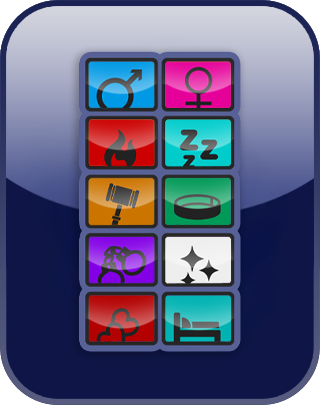Sex Values Test
The Sex Values Test is a spin on the popular 8 Values Test, but pertaining to erotic endeavors rather than politics. The test is purely casual and rough around the edges. It’s more of a self-reflection tool than a scientific assessment, as it is not created by a formal research entity.
Question 1 of 27
I would have relationships with women.
| Disagree | Agree |
NEXT
The Sex Values Test is an online test designed to map an individual's sexual preferences and tendencies across five distinct axes. It’s built on a modified framework of the 8 Values quiz, which originally focused on political ideologies but is adapted here to explore aspects of sexuality. The test presents users with a series of statements, and they respond with their level of agreement—ranging from "Strongly Agree" to "Strongly Disagree." Each answer influences scores across the five axes, and at the end, results are displayed as percentages comparing your responses to the maximum possible score for each value.
The five axes and their opposing values are:
- Attraction (Masculine vs. Feminine): Measures preference toward masculine traits (e.g., strength, independence) or feminine traits (e.g., emotionality, kindness). A higher Masculine score suggests attraction to masculinity or males, while a higher Feminine score indicates attraction to femininity or females.
- Sex Drive (Hypersexual vs. Hyposexual): Assesses libido levels. Hypersexual leans toward frequent or intense sexual desire, while Hyposexual reflects lower interest or drive.
- Dominance (Dominant vs. Submissive): Evaluates preference for control or yielding in sexual dynamics. Dominant scores indicate a tendency to take charge, while Submissive scores suggest a preference for relinquishing control.
- Deviance (Deviant vs. Pure): Gauges inclination toward unconventional or taboo sexual interests versus more traditional or "vanilla" preferences. Deviant reflects openness to kinks or non-standard practices, while Pure aligns with conventional norms.
- Affection (Affective vs. Hedonist): Explores the emotional context of sexuality. Affective indicates a preference for intimacy tied to emotional connection, while Hedonist suggests a more casual, pleasure-focused approach not exclusive to partners.
The quiz is self-described as a "legacy" version, implying it’s an earlier iteration that may be rough around the edges or slated for replacement. It includes a disclaimer noting its imperfections, and the creator has made updates like adding a demographic questionnaire and rewording questions. Results can optionally be recorded anonymously (with or without demographic data) or not recorded at all, and the site uses Google Analytics for tracking. It’s licensed under the MIT License, meaning it’s open for anyone to use, modify, or distribute freely.
The test aims to provide a personalized snapshot of your sexual identity based on your responses, though its accuracy depends on honest answers and its framework’s ability to capture complex human preferences. It’s more of a self-reflection tool than a scientific assessment, as it is not created by a formal research entity.
Permission is hereby granted, free of charge, to any person obtaining a copy of this software and associated documentation files (the "Software") to deal in the Software without restriction, including without limitation the rights to use, copy, modify, merge, publish, distribute, sublicense, and/or sell copies of the Software, and to permit persons to whom the Software is furnished to do so, subject to the following conditions:
The above copyright notice and this permission notice shall be included in all copies or substantial portions of the Software.
THE SOFTWARE IS PROVIDED "AS IS," WITHOUT WARRANTY OF ANY KIND, EXPRESS OR IMPLIED, INCLUDING BUT NOT LIMITED TO THE WARRANTIES OF MERCHANTABILITY, FITNESS FOR A PARTICULAR PURPOSE, AND NONINFRINGEMENT. IN NO EVENT SHALL THE AUTHORS OR COPYRIGHT HOLDERS BE LIABLE FOR ANY CLAIM, DAMAGES, OR OTHER LIABILITY, WHETHER IN AN ACTION OF CONTRACT, TORT, OR OTHERWISE, ARISING FROM, OUT OF, OR IN CONNECTION WITH THE SOFTWARE OR THE USE OR OTHER DEALINGS IN THE SOFTWARE.

 English
English  Español
Español  Português
Português  Deutsch
Deutsch  Français
Français  Italiano
Italiano  Polski
Polski  Русский
Русский  Türkçe
Türkçe  العربية
العربية  日本語
日本語  한국어
한국어  ไทย
ไทย  汉语
汉语  हिन्दी
हिन्दी  Bahasa
Bahasa 